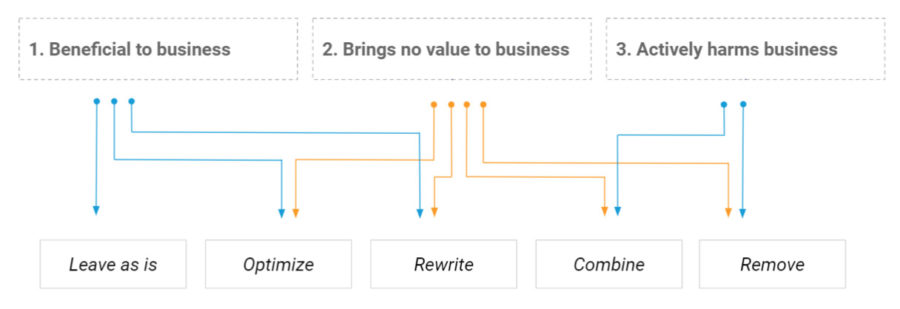What is an SEO content audit?
Content auditing is the process of reviewing all of your website content and assessing strengths and weaknesses to determine the best course of action for each piece of content moving forward. The process provides an opportunity for anyone who is managing website content to take a closer look at KPIs (key performance indicators) associated with each page to ensure that the content across your website meets your goals, quality, and performance standards.
This blog post focuses on content audits, but specifically for the purpose of organic search engine optimization. SEO content audits are the same as what we described above, but the KPIs we use to measure the content performance against are more focused on organic search performance metrics. Later on, we will discuss what specific SEO performance metrics we look at to determine content performance and what to do with your content.
Purpose of an SEO content audit
The purpose of an SEO content audit is to improve the performance of your website content, drive more qualified organic visitors into your website, and ensure that your content meets Google’s quality guidelines. Auditing is a great opportunity to take a step back and look at the bigger picture of your website content performance to determine a clear roadmap of recommendations and areas for improvement. Content audits can be done across your entire website or focused on specific sections of your website, such as a resource center or blog. One of the most common content audits we do within SEO are blog content audits. This is because blog content is updated more frequently and we tend to see fluctuations in blog performance aligned with Google’s Core Updates (more on that later!).
Which performance metrics should you measure your content against?
When building your content audit, you’ll want to identify a list of performance metrics that you’re using to measure the content against. For SEO content audits, we analyze a variety of organic search data points to understand how each piece of content is currently performing. We use the following data to help us make the most informed decisions on what needs to be done with each piece of content to meet our key objectives of improving organic traffic and engagement.
Overall Traffic.
How much traffic is the blog post currently generating on average? We look at both All Traffic and Organic Traffic to get a full picture view of performance. Sometimes you’ll see a content piece is driving a lot of traffic from other sources, but organic is suffering. That presents an opportunity to further optimize that post to boost that organic visibility.
Organic Engagement Data.
We look at Organic Clicks, Organic Impressions, and CTR (click-through-rate) to understand the overall organic demand around the content piece. If a piece of content is receiving high impressions, but low clicks, we know there is demand around the topic and an opportunity to rewrite or further optimize the content to drive performance.
Keyword Data.
What is the average organic ranking position for this page? How many different keywords is the page currently ranking for? What is the top-ranking keyword and search volume for that page?
Backlinks and Referring Domains.
How many backlinks or referring domains are sending traffic to the page? This is important to analyze as part of your content audit because a page with a high volume of referring domains, but little traffic, is still a valuable piece of content that should likely be rewritten and redirected to maintain that equity received from those backlinks.
Before making a final decision, we also perform a manual on-page content evaluation of the page itself. With this analysis, we are looking for things like internal linking, content quality, content relevancy, supporting image assets, and so on. Our team references the guidelines below when we perform an on-page content evaluation to determine the overall quality of the content.
Useful and Informative.
The website content is written to inform and educate users, whether that is helping answer a specific question a user may have, helping the user learn about different products/services offered or to simply help a user find company contact info and hours of operation. The quality of all content comes down to one simple question: Is this content useful to my site visitors?
Credible.
Is the content trustworthy and credible? Do we provide testimonials or thought leadership pieces that help educate visitors? Do we show the website’s credibility by using original research, citations, external links, and authorship? For example: Consider assigning an author to content articles to drive subject matter expertise, a unique point of view, and original thoughts.
High Quality.
Does the content align with user expectations? Are we answering the user’s question and providing value? Is the content educational, informative, and well-written? The key here is to avoid mass-produced, duplicate, or thin content. Write for the user – NOT the search engines.
Competitive.
It’s important that website content stands out from others in the field. For example, if writing on a specific topic such as how to improve your blood pressure – it’s important to do competitive research to understand the landscape, and then find an angle that’s unique, that offers a different perspective than competitors or that goes into more depth than other articles on that same topic.
Engaging.
Outside of the written content on the website, are we using images, CTA buttons, social media widgets, and email sign-up forms to compel users to not only read our content but to engage with it? This also includes things like using headers to add structure and subtopics to content articles so users can easily read and scan the information you’re presenting them. Also, driving engagement by offering users to navigate to other pages on the website through internal linking.
Measuring your website content against these performance metrics and quality guidelines allows you to take a closer look at your content to identify opportunities to improve performance.
How to determine what to do with your website content
When it comes to building your content audit spreadsheet, there are endless ways to organize and pull the data. You can find quite a few great online resources and templates that provide ideas on how best to structure your audit, so we recommend exploring those as a starting point. Just Google: Content Audit Template.
Once you’ve assembled your content audit spreadsheet with the performance metrics we’ve outlined above, it’s time to get to work assessing your content. While you are comparing your content against those primary KPIs, you’ll be able to begin assigning what we refer to as Content Directives, which are essentially recommended actions for each piece of content in your audit. It’s important to have a Recommended Action column in your content audit spreadsheet so you can easily assign one of the five directives to each page as you make your way down the spreadsheet.
The five content directives that we use to categorize the recommended next step for each page include:
Leave As-Is.
The content is performing well, gaining traffic through organic or other channels, or is essential to the user funnel. Content should not be changed.
Optimize.
The content has potential but needs improvements to keyword targeting, on-page SEO, and page structure in order to perform well organically. Often, this means identifying the right keywords to target on the page, updating page titles and meta descriptions, updating the headers, improving internal linking strategy, adding supporting images, and so on.
Rewrite.
The content topic has the potential to rank for relevant keywords but will need a complete rewrite to perform competitively. Often, the topic of the content that falls within this directive remains relevant and useful to website visitors, but it’s poorly written, has thin content or the content is outdated.
Combine.
Multiple pieces of content on very similar topics can be combined into a singular piece of content that has a higher potential to rank organically. Combining content that is too similar will also help combat keyword cannibalization.
Remove.
The content is not performing against any of the key performance metrics, or the topic is outdated or irrelevant to the business. In this case, the content has very low potential for improvement based on the search landscape and the topic itself. During the content auditing process, we look to “trim the fat” off your website by removing any unnecessary or underperforming content so Google is only crawling content that we feel confident will perform and help drive more qualified visitors into the website.
Below are two illustrations that our Senior Technical SEO Manager, Erik Martin, created to help demonstrate the decision-making process of categorizing content into these different content directives. These are important questions to ask yourself as you are auditing your own content.

How often should you perform an SEO content audit?
It’s important to perform regular content audits on your website to keep track of changes in content performance and make recommendations accordingly. We typically audit our client’s website content on a quarterly basis, especially for websites that consistently publish new content, often on a blog or resource center.
Another important time to audit your website content is when Google releases a Core Update. Google’s Core Updates refers to when Google makes significant changes to its search algorithm that are primarily designed to ensure that the search engine is delivering the most relevant, reliable information (content) to its users. Core Updates may have a significant impact on a website’s organic search traffic from Google, so when an update is released, it’s important to take inventory of the content on your website. Performing a content audit after a Core Update will help you understand how the Core Update may have impacted your content performance, and most importantly, what needs to be done to your content to meet Google’s new standards of content quality, improve traffic, and key performance metrics.
Tools for SEO content audits
Our SEO team taps into a variety of tools to help us perform the most accurate, effective content audits and analysis. Included in our toolkit for content auditing are Google Analytics, Google Search Console, Ahrefs, and SEMrush. These tools allow us to pull performance data that we measure the content against. We also use Screaming Frog and Yoast SEO to crawl the website and pull SEO metadata to quickly identify pages that need further optimization.
Additionally, when reviewing individual pieces of content, our team turns to on-page SEO plugins to quickly see information like metadata, canonicals, header tags, web vitals, schema markup, and more. Two of my favorite SEO plugins are the SEO Pro Extension by MarketingSyrup and Portent SERP Preview Tool. Tools like Grammarly are also helpful in quickly identifying any spelling errors, typos, and grammar errors to ensure your content is flawless.
The most common SEO mistakes uncovered during a content audit
Our team has conducted many SEO content audits in our careers. And I can confidently say that for each audit I’ve done, there are consistent mistakes that I uncover regardless of the brand, industry, or audience. A few of the most common SEO mistakes that are uncovered during content audits include:
- Pages missing SEO metadata
- Pages with unoptimized SEO metadata and metadata that doesn’t follow Google’s guidelines
- Outdated content that hasn’t been updated with recent information
- Content that mentions or externally links out to old statistics
- Thin content
- Pages without a primary call-to-action
- Broken internal or external links
- Pages lacking internal linking to other relevant website pages
- Pages lacking image assets
- Pages with image assets that are not optimized for SEO, missing image alt text, or file sizes that are too large
- Pages lacking structure or optimized headers (h1s, h2s, etc.)
- Inconsistent content styling, such as the use of italics or bolding in
This list of common mistakes is a great starting point when you begin your own website content audit.
I hope this blog introduced you to how we approach SEO content audits and more importantly, how conducting an audit will help improve your website traffic and content performance. Our SEO team would love to help you audit the content on your website to ensure you’re driving the most relevant, qualified visitors into your website. Explore our approach to organic search to learn more about our SEO capabilities, and get in touch with us if you’d like to learn more!














